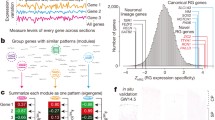Abstract
Cell proliferation is an essential force to build up the size, shape, and function of an organ. This force is particularly prominent in the production of the cerebellar granule neurons, which represent 80% of all brain neurons. Extensive cell biological and tissue transplantation studies have uncovered both long-range diffusible and local cell-cell, contact-dependent growth cues for the granular neurons. The assignment of specific gene products to their contributions to the genesis of the granular neurons is greatly facilitated byin vitro culture assays and knock-out mouse analyses. Among them, theGrowth arrest specific gene 1 (Gas1), a known negative regulator of the cell cycle, was shown to have profound influence on the production of the granule cells. Our aim here is to review the contributions ofGas1 and a few other selected genes and put them into a more comprehensive framework, through it may be speculative at times, of granule cell proliferation regulation.
Similar content being viewed by others
References
Liu Y, May NR, Fan CM. Growth arrest specific gene 1 is a positive growth regulator for the cerebellum. Dev. Biol 2001; 236: 30–45.
Hatten ME, Heintz N. Mechanisms of neutral patterning and specification ion the developing cerebellum. Annu Rev Neurosci 1995; 18: 385–408.
Altman J, Bayer SA. Development of the cerebellar system. Boca Raton, FL: CRC Press, 1997.
Schneider C, King RM, Philipson L. Genes specficially expressed at growth arrest of mammalian cells. Cell 1998; 54: 787–793.
Stebel M, Vatta P, Ruaro ME, Del Sal G, Parton RG, Schneider C. The growth suppressing Gas1 product is a GPI-linked protein. FEBS Lett 2000; 481: 152–158.
Lee CS, Fan CM. Embryonic expression patterns of the mouse and chick Gas1 genes. Mech Dev 2001; 101: 293–297.
Del Sal G, Ruaro ME, Philipson L, Schneider C. The growth arrest-specific gene Gas1 is involved in growth suppression. Cell 1992; 70: 595–607.
Evdokiou A, Cowled PA. Tumor-suppressive activity of the growth arrest-specfici gene Gas1 in human tumor cell lines. Int J Cancer 1998; 75: 568–577.
Ruaro ME, Collavin L, Del Sal G, Haffner R, Oren M, Levine AJ, Schneider C. A proline-rich motif in p53 is required for transactivation-independent growth arrest as induced by Gas1. Proc. Natl Acad Sci 1997; 94: 4675–4680.
Ruaro ME, Stebel M, Vatta P, Marzinotto S, Schneider C. Analysis of the domain requirement in Gas1 growth suppressing activity. FEBS Lett 2000; 481: 159–163.
Lee KK, Leung AK, Tang MK, Cai DQ, Schneider C, Brancolini C, Chow PH. Functions of the growth arrest specific 1 gene in the development of the mouse embryo. Dev Biol 2001; 234; 188–203.
Lee CS, May NR, Fan CM. Transdifferentiation of the ventral retinal pigmented epithelium to neural retina in the growth arrest specific gene 1 mutant. Dev Biol 2001; 236: 17–29.
Ben-Arie N, Bellen HJ, Armstrong DL, McCall AE, Gordadze PR, Guo Q, Matzuk MM, Zoghbi HY. Mathl is essential for genesis of cerebellar granule neurons. Nature 1997; 390: 169–172.
Aruga J, Minowa O, Yaginuma H, Kuno J, Nagai T, Noda T, Mikoshiba K. Mouse Zicl is involved in cerebellar development. J Neurosci 1998; 18: 284–293.
Miyata T, Maeda T, Lee JE. NeuroD is required for differentiation of the granule cells in the cerebellum and hippocampus. Genes Dev 1999; 13: 1647–1652.
Huard JM, Forster CC, Carter ML, Sicinski P, Ross ME. Cerebellar histogenesis is disturbed in mice lacking cyclin D2. Development 1999; 126: 1925–1935.
Sneyne RJ, Chu T, Lewin A, Bian F, S-Crisman S, Kunsch C, Lira SA, Oberdick J. Local control of granule cell generation by cerebellar Purkinje cells. Mol Cell Neurosci 1995; 6: 230–251.
Gao WO, Heintz N, Hatten ME. Cerebellar granule cell neurogenesis is regulated by cell-cell interactions in vitro. Neuron 1991; 6: 705–715.
Wechsler-Reya RJ, Scott MP. Control of neuronal precursor proliferation in the cerebellum by sonic hedgehogy. Neuron 1999; 22: 103–114.
Dahmane N, Ruiz-i-Altaba A. Sonic hedgehog regulates the growth and patterning of the cerebellum. Development 1999; 126: 3089–3100.
Kenney AM, Rowitch DH. Sonic hedgehog promotes G1 cyclin expression and sustained cell cycle progression in mammalian neuronal precursors. Mol. Cell Biol 2000; 20: 9055–9067.
Mizugishi K, Aruga J, Nakata K, Mikoshiba K. Molecular properties of ZIC proteins as transcriptional regulators and their relationship to GLI proteins. J Biol Chem 2001; 276: 2180–2188.
Lee CS, Buttitta L, Fan CM. Evidence that the WNT-inducible growth arrest-specific gene 1 encodes an antagonist of sonic hedgehog signaling in the somite. Pro Natl Acad Sci USA 2001; 98: 11347–11352.
Stone DM, Hynes M, Armanini M, Swanson TA, Gu Q, Johnson RL, Scott MP, Pennica D, Goddard A, Phillips H, Noll M, Hooper JE, de Sauvage F, Rosenthal A. The tumour-suppressor gene patched encodes a candidate receptor for Sonic hedgehog. Nature 1996; 384: 129–134.
Marigo V, Johnson RL, Vortkamp A, Tabin CJ. Sonic hedgehog differentially regulates expression of GLI and GLI3 during limb development. Dev Biol 1996; 180: 273–283.
Zheng X, Goetz J, Suber LM, Scott WJ, Schreiner CM, Robbins DJ. A freely diffusible form of sonic hedgehog mediates longrange signaling. Nature 2001; 411: 716–720.
Sicinski P, Donahe JL, Parker SB, Li T, Fazeli A, Gardner H, Haslam SZ, Bronson RT, Elledge SJ, Weinberg RA. Cyclin D1 provides a link between development and oncogenesis in the retina and breast. Cell 1995; 82: 621–630.
Bartkova J, Lukas J, Strauss M, Bartek J. Cyclin D3: requirement for G1/S transition and high abundance in quiescent tissues suggest a dual role in proliferation and differentiation. Oncogene 1998; 17: 1027–1037.
Barnes EA, Kong M, Ollendorff V, Donoghue DJ. Patchedl interacts with cyclin B1 to regulate cell cycle progression. EMBO J 2001; 20: 2214–2223.
Author information
Authors and Affiliations
Corresponding author
Rights and permissions
About this article
Cite this article
Marques, G., Fan, CM. Growth arrest specific gene 1: a fuel for driving growth in the cerebellum. Cerebellum 1, 259–263 (2002). https://doi.org/10.1080/147342202320883560
Received:
Revised:
Accepted:
Issue Date:
DOI: https://doi.org/10.1080/147342202320883560




